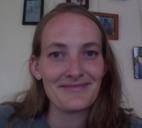By
Annie Perkins, posted October 11, 2016 —
One of the greatest benefits I found
doing the Mathematician Project involved what my students revealed about
themselves. Simply by asking my students who they wanted to learn about, I
learned information about them that I had not yet picked up on. They made some
immediate and unsurprising mathematician requests: “African-American,” “female,”
and “Mexican.” They also made some unexpected requests. “El Salvadorian” led to
a discussion of one student’s family. “Deaf” brought up a passion for American
Sign Language (ASL) that I didn’t know about. Students made requests like “Blasian
people (mixed with Asian and black like me),” “Light-skinned black with curly
hair,” “I just want to hear about more women,” and the very enthusiastic “LGBTQ mathematicians! Nonbinary
and trans mathematicians!” (This last response was written by one student in
all caps.) My students started talking more openly with me about their lives
and what mattered to them.
Most presentations ended up being a fun thing we did that day, but
occasionally a student would get emotional. When I made a presentation about a
trans mathematician, one student who was yet unsure how they identified
spoke up to say (of the trans mathematician), “They’re a really good person.”
It was clear how deeply affecting it had been to see a successful mathematician
with whom this student could identify.
Being curious about more than
surface reactions, I periodically surveyed my students to ask how they felt about
the project. I freely admit it; some students replied with “Boring” or “At least
we’re not doing math,” but the vast majority responded with thoughtful
comments:
• “I like it. I hope we keep doing it in the future.”
• “We
should do them twice a week because I know that there are a lot more and this
is our last year to learn about them.”
• “I think you should do this every year until you stop
teaching.”
• “Not
to be racist but . . . I only like when a black person is being
presented, because not a lot of people believe that blacks are smart or not
even think that a black person can be a mathematician. Thank u.”
After several months of the
project, I asked students to present themselves as mathematicians. The
instructions were for students to create a “slide” (out of card stock) of
themselves as a mathematician, sharing what they cared about most (it could be
anything) and what their mathematical specialty was. We took several days to
complete the project. While students were coloring or adding glitter to their
slide, I roamed the room, having one-on-one conversations with students about
their mathematical specialties. There were a great many students who felt that they
didn’t have one, and I was really glad I took the time to sit down and have these
discussions. I encouraged students to think of their specialty as something
they felt accomplished in or something they were proud they understood after
working on for a long time. Those conversations revealed a lot about how my
students saw themselves as mathematicians; it gave me a chance to affirm to
them that I did believe that they were capable. They saw me placing value on
their self-respect.
I
am as guilty as the next math teacher for claiming that our subject makes it
difficult to have conversations that teach us about our students. I am pleased
to say that this project has helped me overcome that. It has made my job more
enjoyable and my relationships with students better.

Annie
Perkins teaches math in Minneapolis, Minnesota. For the past three years, she
has taught seventh- and eighth-grade math at Lake Nokomis Community School–Keewaydin.
This year she will be teaching tenth grade at Southwest High School. She blogs
at arbitrarilyclose.com, and you can reach her on
twitter @anniekperkins.